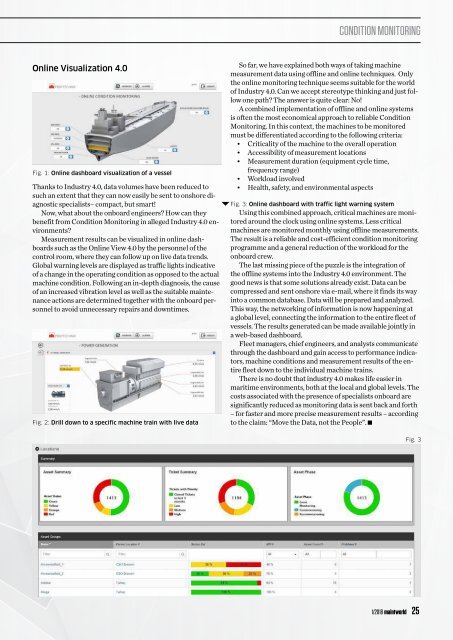Maintworld 1/2018
The Use and Misuse of Vibration Analysis // The Industrial Iot Maturity Model // Condition Monitoring in Maritime Applications // Effective Backlog Management
The Use and Misuse of Vibration Analysis // The Industrial Iot Maturity Model // Condition Monitoring in Maritime Applications // Effective Backlog Management
You also want an ePaper? Increase the reach of your titles
YUMPU automatically turns print PDFs into web optimized ePapers that Google loves.
CONDITION MONITORING<br />
Online Visualization 4.0<br />
Fig. 1: Online dashboard visualization of a vessel<br />
Thanks to Industry 4.0, data volumes have been reduced to<br />
such an extent that they can now easily be sent to onshore diagnostic<br />
specialists– compact, but smart!<br />
Now, what about the onboard engineers? How can they<br />
benefit from Condition Monitoring in alleged Industry 4.0 environments?<br />
Measurement results can be visualized in online dashboards<br />
such as the Online View 4.0 by the personnel of the<br />
control room, where they can follow up on live data trends.<br />
Global warning levels are displayed as traffic lights indicative<br />
of a change in the operating condition as opposed to the actual<br />
machine condition. Following an in-depth diagnosis, the cause<br />
of an increased vibration level as well as the suitable maintenance<br />
actions are determined together with the onboard personnel<br />
to avoid unnecessary repairs and downtimes.<br />
Fig. 2: Drill down to a specific machine train with live data<br />
So far, we have explained both ways of taking machine<br />
measurement data using offline and online techniques. Only<br />
the online monitoring technique seems suitable for the world<br />
of Industry 4.0. Can we accept stereotype thinking and just follow<br />
one path? The answer is quite clear: No!<br />
A combined implementation of offline and online systems<br />
is often the most economical approach to reliable Condition<br />
Monitoring. In this context, the machines to be monitored<br />
must be differentiated according to the following criteria:<br />
• Criticality of the machine to the overall operation<br />
• Accessibility of measurement locations<br />
• Measurement duration (equipment cycle time,<br />
frequency range)<br />
• Workload involved<br />
• Health, safety, and environmental aspects<br />
Fig. 3: Online dashboard with traffic light warning system<br />
Using this combined approach, critical machines are monitored<br />
around the clock using online systems. Less critical<br />
machines are monitored monthly using offline measurements.<br />
The result is a reliable and cost-efficient condition monitoring<br />
programme and a general reduction of the workload for the<br />
onboard crew.<br />
The last missing piece of the puzzle is the integration of<br />
the offline systems into the Industry 4.0 environment. The<br />
good news is that some solutions already exist. Data can be<br />
compressed and sent onshore via e-mail, where it finds its way<br />
into a common database. Data will be prepared and analyzed.<br />
This way, the networking of information is now happening at<br />
a global level, connecting the information to the entire fleet of<br />
vessels. The results generated can be made available jointly in<br />
a web-based dashboard.<br />
Fleet managers, chief engineers, and analysts communicate<br />
through the dashboard and gain access to performance indicators,<br />
machine conditions and measurement results of the entire<br />
fleet down to the individual machine trains.<br />
There is no doubt that industry 4.0 makes life easier in<br />
maritime environments, both at the local and global levels. The<br />
costs associated with the presence of specialists onboard are<br />
significantly reduced as monitoring data is sent back and forth<br />
– for faster and more precise measurement results – according<br />
to the claim: “Move the Data, not the People”.<br />
Fig. 3<br />
1/<strong>2018</strong> maintworld 25

















